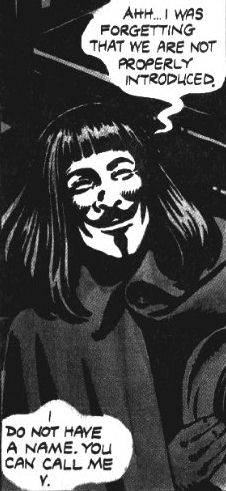
Comic books are, at least, as old as movies. Their first steps were set in the beginning of XXth Century, in the search of new ways of graphic and visual communication and expression. Usually, comic books are also associated with the prehistoric paintings in caves and Egyptian hieroglyphics, all of them visual narratives of juxtaposed images. The existence of words was not mandatory, but with the adoption of symbols to represent them -- letters --, they were soon added to give more information and boost the narrative flow. The improvement of press and printing technology were strong factors to the development of the medium.
Among the precursors can be mentioned Swiss Rudolph Töpffer, German Wilhelm Bush, French Georges ("Christophe") Colomb and brazilian Angelo Agostini, but it is usual to associate the first comic book to Richard Fenton Outcalt's creation, The Yellow Kid, in 1896. Outcalt essentially synthesized what had been made before him and introduced a new element: the balloon, a space where he wrote what the characters said, and that pointed to their mouth with a kind of tail.
The bases for a brand new kind of art were set, and the adventure begun. In the first decades of its life, comic books were essentially humoristic, and this is the explanation for the name they carry to date in English language. Some of those days' creations can be read until today, and are among the best stories in comic book's History: Little Nemo in Slumberland (by Winsor McCay), Mutt & Jeff (by Bud Fisher), Popeye (by E. Segar) and Krazy Kat (by George Herriman). However, comic books have other denominations, such as Italian fumetti (smoke, an allusion to the shape of the balloon), French bande dessiné; (drawn strip), Japanese manga and Portuguese história em quadradinhos (story in little squares), much more comprehensive.




 The
crack of the Stock Market in 1929 was a turning
point in comic book's history, and in the 30's comic books grew up, starting
to picture adventures. Alex Raymond's Flash Gordon, Chester
Gould's Dick Tracy and Hal Foster's adaptation of E.
R. Borroughs' Tarzan were those days paradigms, now known as
The Golden Age. Three essential types, the science fiction, detective
stories and jungle adventures spread their tentacles, respectively
based in each of the above stories. While Foster's Tarzan
was a full of action, without balloons adaptation of the book by Borroughs,
and Gould's Dick Tracy was partially inspired by the
gang wars of Chicago (where Gould lived), Flash Gordon was
a
The
crack of the Stock Market in 1929 was a turning
point in comic book's history, and in the 30's comic books grew up, starting
to picture adventures. Alex Raymond's Flash Gordon, Chester
Gould's Dick Tracy and Hal Foster's adaptation of E.
R. Borroughs' Tarzan were those days paradigms, now known as
The Golden Age. Three essential types, the science fiction, detective
stories and jungle adventures spread their tentacles, respectively
based in each of the above stories. While Foster's Tarzan
was a full of action, without balloons adaptation of the book by Borroughs,
and Gould's Dick Tracy was partially inspired by the
gang wars of Chicago (where Gould lived), Flash Gordon was
a  product
of total imagination of Raymond, which would give also Secret
Agent X-9, Jim of the Jungle (competing with Dick Tracy
and Tarzan, respectively) and Rip Kirby. Foster did
also a historic masterpiece on comics, Prince Valiant, medieval
adventure with academic accuracy. About this time was created the first
costumed character, the Phanton, written by Lee Falk and
masterly drawn by Ray Moore. Falk is one of the best comic
book writers of all time and probably the one that stood more time with
the same character -- more than 50 years! Falk also created Mandrake
the Magician, with pencils by Phil Davis.
product
of total imagination of Raymond, which would give also Secret
Agent X-9, Jim of the Jungle (competing with Dick Tracy
and Tarzan, respectively) and Rip Kirby. Foster did
also a historic masterpiece on comics, Prince Valiant, medieval
adventure with academic accuracy. About this time was created the first
costumed character, the Phanton, written by Lee Falk and
masterly drawn by Ray Moore. Falk is one of the best comic
book writers of all time and probably the one that stood more time with
the same character -- more than 50 years! Falk also created Mandrake
the Magician, with pencils by Phil Davis.
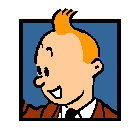
(About this time there were great comic books in other places besides USA, like France and Belgium, but they were barely known out of their birth countries. Of particular interest is Belgic Hergé's Tintin, who practically created the clean line style, and had lots of followers (and imitators)).
The outcome of this process
was that the birth of a typically American comic was born: the super-hero,
with Siegel and Shuster's Superman. Superman
is a landmark -- for a lot of people his début is the start the
Golden Age -- in Comic book History, a perfect archetype, the model
to lots of characters and one of the most perfect myths of modern
ages. Lots of academic studies and dissection works have been made about
him along his near 60 years of life. And lots of bucks, too.
Both his creators died in the nineties, without a small fraction of this
fortune, because they sold the rights of the character in 40's to DC
Comics.
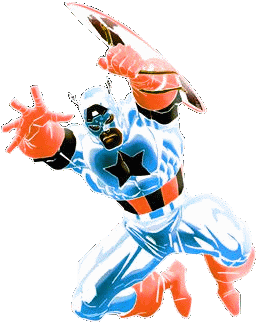 The Comics evolved, and spread its arms, becoming part of mass culture.
In the period 1940-1945 some four hundred super heroes were created,
mostly based in Superman's model, though only a few survived. Two
of them deserve to be highlighted: Batman, created in 1939 by Bob
Kane, a darker character (inspired in Da Vinci's flying
machine and Zorro) whose fame would exceed Superman's in
the 80's, and Captain Marvel, by C.C. Beck, a yon boy that
earned magical powers every time he said the magic word Shazam!,
an acronym of names of old gods. A lot of characters were enlisted and
went to the World War II, and comic books became ideological weapons
to increase soldiers and people moral. The greatest icon of those war days
is Jack Kirby and Joe Simon's Captain America. To
say the least, in the cover of his first magazine, Captain America
battled no one other than Adolf Hitler himself.
The Comics evolved, and spread its arms, becoming part of mass culture.
In the period 1940-1945 some four hundred super heroes were created,
mostly based in Superman's model, though only a few survived. Two
of them deserve to be highlighted: Batman, created in 1939 by Bob
Kane, a darker character (inspired in Da Vinci's flying
machine and Zorro) whose fame would exceed Superman's in
the 80's, and Captain Marvel, by C.C. Beck, a yon boy that
earned magical powers every time he said the magic word Shazam!,
an acronym of names of old gods. A lot of characters were enlisted and
went to the World War II, and comic books became ideological weapons
to increase soldiers and people moral. The greatest icon of those war days
is Jack Kirby and Joe Simon's Captain America. To
say the least, in the cover of his first magazine, Captain America
battled no one other than Adolf Hitler himself.
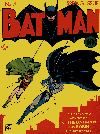 In the 40's, the magazine format of comic books as we know today
was created, as well as one of the best comic books ever conceived, Will
Eisner's The Spirit, an anthological work that last twelve years with
the help of soon-to-be-known famous names, like Bob Kane (creator
of Batman), Jack Kirby and cartoonist Jules Feiffer.
With only seven weekly pages, inserted in the Sunday supplement of a journal,
Eisner created a full encyclopedia of comic books, using
each of the comic books' basic elements in a new and creative way, beginning
each story with a different logo for The Spirit, with an intense
use of perspective and shadow. With subjects far more mature than the typically
super-hero's stories, The Spirit is the starting point for a series
of tales dealing with everyman's life and problems, usual subjects in later
Eisner's works. Aside with Milton Caniff's Terry
and the Pirates, The Spirit is one of the best comic books of
that decade (if not the one ever made).
In the 40's, the magazine format of comic books as we know today
was created, as well as one of the best comic books ever conceived, Will
Eisner's The Spirit, an anthological work that last twelve years with
the help of soon-to-be-known famous names, like Bob Kane (creator
of Batman), Jack Kirby and cartoonist Jules Feiffer.
With only seven weekly pages, inserted in the Sunday supplement of a journal,
Eisner created a full encyclopedia of comic books, using
each of the comic books' basic elements in a new and creative way, beginning
each story with a different logo for The Spirit, with an intense
use of perspective and shadow. With subjects far more mature than the typically
super-hero's stories, The Spirit is the starting point for a series
of tales dealing with everyman's life and problems, usual subjects in later
Eisner's works. Aside with Milton Caniff's Terry
and the Pirates, The Spirit is one of the best comic books of
that decade (if not the one ever made).
The 50's
staged the greatest witch-hunt of comics ever, and a lot
of prejudice from those  days
still remains. Psychiatrist Frederic Wertham wrote a book, The
Seduction of the Innocent, where he accused comic books of causing
youth corruption and juvenile delinquency. Among any other weird subjects,
he accused comics of inciting youth to violence (what had already happened
with rock'n'roll). A Comics Code
was then created destined to limit and rule on what could appear (and what
could not) in the pages. It destroyed all horror titles from EC Comics,
except for one, an humoristic mag, that remains until today: Mad.
days
still remains. Psychiatrist Frederic Wertham wrote a book, The
Seduction of the Innocent, where he accused comic books of causing
youth corruption and juvenile delinquency. Among any other weird subjects,
he accused comics of inciting youth to violence (what had already happened
with rock'n'roll). A Comics Code
was then created destined to limit and rule on what could appear (and what
could not) in the pages. It destroyed all horror titles from EC Comics,
except for one, an humoristic mag, that remains until today: Mad.
 Another
great story was born those hard days, an apparently innocent strip about
a group of children: Peanuts, by Charles M. Schulz. Charlie
Brown, the main character, is a 6 year old boy, born to loose. He symbolizes
the insecurity, the ingenuity, the lack of initiative; an eternal hopper.
His dog, Snoopy, is a philosophic beagle in the top of his red house.
This strip starts the thinking and intellectual age of comics,
with a greater valorization of the text over the images. The other great
name of the 50's intellectual comics is Jules Feiffer, who
retracted paranoia and obsessions of compulsive people from the American
society with a free, undefined drawing style, without background, mainly
in monologues, in the Village Voice. In times of limited freedom
of speech and witch-hunt, the creators (in theater and in movies as much
as in comics) used apparently inoffensive stories to say in the interlineation
what they wanted. Walt Kelly's Pogo is another example, which
used small animals in the swamps of Florida to discuss politics.
Another
great story was born those hard days, an apparently innocent strip about
a group of children: Peanuts, by Charles M. Schulz. Charlie
Brown, the main character, is a 6 year old boy, born to loose. He symbolizes
the insecurity, the ingenuity, the lack of initiative; an eternal hopper.
His dog, Snoopy, is a philosophic beagle in the top of his red house.
This strip starts the thinking and intellectual age of comics,
with a greater valorization of the text over the images. The other great
name of the 50's intellectual comics is Jules Feiffer, who
retracted paranoia and obsessions of compulsive people from the American
society with a free, undefined drawing style, without background, mainly
in monologues, in the Village Voice. In times of limited freedom
of speech and witch-hunt, the creators (in theater and in movies as much
as in comics) used apparently inoffensive stories to say in the interlineation
what they wanted. Walt Kelly's Pogo is another example, which
used small animals in the swamps of Florida to discuss politics.
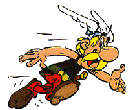 In Europe, by those days, was created one of the best comic books
ever made, the French Astérix, by René Goscinny
(text) and Albert Uderzo (pencils), in Pilote magazine, in
1959. With a huge humor sense, great historic research, wonderful pencils,
Astérix is without any question, a masterpiece.
The stories of the inhabitants of a gaul village, in 50 b.C., mixed adventure,
jokes about mostly European countries (and their people), Latin quotes,
caricatures of French personalities from the 60's and detailed backgrounds
in an easy reading narrative. In 1977 Goscinny died, but the story
didn't end: Uderzo followed drawing and, then, also writing the
albums -- until today. Astérix is the top-one best seller
in French.
In Europe, by those days, was created one of the best comic books
ever made, the French Astérix, by René Goscinny
(text) and Albert Uderzo (pencils), in Pilote magazine, in
1959. With a huge humor sense, great historic research, wonderful pencils,
Astérix is without any question, a masterpiece.
The stories of the inhabitants of a gaul village, in 50 b.C., mixed adventure,
jokes about mostly European countries (and their people), Latin quotes,
caricatures of French personalities from the 60's and detailed backgrounds
in an easy reading narrative. In 1977 Goscinny died, but the story
didn't end: Uderzo followed drawing and, then, also writing the
albums -- until today. Astérix is the top-one best seller
in French.
 In the sixties we can
see the remake of the super hero with the Marvel Comics, by Stan
Lee and Jack Kirby. Lee and Kirby already worked
with comic books and super heroes, but then, they had the opportunity of
creating an entire new fictional universe. The surprise was that the characters
had some kind of weakness or defect in opposition to their super powers.
Fantastic Four, Silver Surfer, Thor, Hulk,
X-Men, Iron Man, Dr. Strange were the first of an
empire that soon would turn Marvel in the number one in comic book
market. But the most popular character and one of the most interesting
super heroes ever created is the Spiderman, the secret identity
of frail and shy teenager Peter Parker.
In the sixties we can
see the remake of the super hero with the Marvel Comics, by Stan
Lee and Jack Kirby. Lee and Kirby already worked
with comic books and super heroes, but then, they had the opportunity of
creating an entire new fictional universe. The surprise was that the characters
had some kind of weakness or defect in opposition to their super powers.
Fantastic Four, Silver Surfer, Thor, Hulk,
X-Men, Iron Man, Dr. Strange were the first of an
empire that soon would turn Marvel in the number one in comic book
market. But the most popular character and one of the most interesting
super heroes ever created is the Spiderman, the secret identity
of frail and shy teenager Peter Parker.

 Times changes, and so
comic books, in sixties. Examples of what we call today adult comics became
more usual, opening space for the creation of stories such as French Barbarella,
by Jean Claude Forest; argentine Mafalda, by Quino;
Italian Valentina, by Guido Crepax; north American Fritz
the Cat, by Robert Crumb (who introduced
the underground in comic books); and for the embryonic works in
science fiction and fantasy of Parisian penciller Jean Giraud, who
later would be better known as Moebius. In all those works
it could be seen sex, violence, intellectual insight, critics to the society,
use of color and page design in very different ways and intensities than
what has been done so far. Comic books are not more only for kids; they
grew up and sophisticated themselves in unexpected ways. Adult comics existed
since the first times, but they increase in number in the 70's. Conventions
and exposition in museums began at the end of that decade, as much as academic
studies.
Times changes, and so
comic books, in sixties. Examples of what we call today adult comics became
more usual, opening space for the creation of stories such as French Barbarella,
by Jean Claude Forest; argentine Mafalda, by Quino;
Italian Valentina, by Guido Crepax; north American Fritz
the Cat, by Robert Crumb (who introduced
the underground in comic books); and for the embryonic works in
science fiction and fantasy of Parisian penciller Jean Giraud, who
later would be better known as Moebius. In all those works
it could be seen sex, violence, intellectual insight, critics to the society,
use of color and page design in very different ways and intensities than
what has been done so far. Comic books are not more only for kids; they
grew up and sophisticated themselves in unexpected ways. Adult comics existed
since the first times, but they increase in number in the 70's. Conventions
and exposition in museums began at the end of that decade, as much as academic
studies.
 The seventies are no more
than a natural consequence of what had begun to happen in the sixties.
Underground comics definitively conquered their space, been sold either
in head shops or hand to hand. Crumb, Gilbert
Shelton's Freak Brothers, S. Clay Wilson, Victor Moscoso,
Dan Griffin are among the most known names, if you can say so, in
underground. On the other side of the ocean, a few French pencillers --
Moebius, Phillipe Druillet, Jean Pierre Dionnet, and
Bernard Farkas --, joined under the name of Les humanoides
associés, created in 1974 a historic magazine, Métal
Hurlant, that came to the USA in 1977, as Heavy Metal. Fantasy,
science fiction, acid trips, rock'n'roll, naked bodies, incredible use
of color, new ways of page design and literature are part of the confuse
mix that made the success of the magazine. From Itally comes great fumetti,
such as Ken Parker, by Berardi and Milazzo, Corto
Maltese, by Hugo Pratt, and The Click, by Milo Manara.
The seventies are no more
than a natural consequence of what had begun to happen in the sixties.
Underground comics definitively conquered their space, been sold either
in head shops or hand to hand. Crumb, Gilbert
Shelton's Freak Brothers, S. Clay Wilson, Victor Moscoso,
Dan Griffin are among the most known names, if you can say so, in
underground. On the other side of the ocean, a few French pencillers --
Moebius, Phillipe Druillet, Jean Pierre Dionnet, and
Bernard Farkas --, joined under the name of Les humanoides
associés, created in 1974 a historic magazine, Métal
Hurlant, that came to the USA in 1977, as Heavy Metal. Fantasy,
science fiction, acid trips, rock'n'roll, naked bodies, incredible use
of color, new ways of page design and literature are part of the confuse
mix that made the success of the magazine. From Itally comes great fumetti,
such as Ken Parker, by Berardi and Milazzo, Corto
Maltese, by Hugo Pratt, and The Click, by Milo Manara. 
In the end of the seventies Will Eisner returns to the comic's stage, inaugurating a new genre, the graphic novel, with A Contract with God. It is the first of a series of tales ambiented in the Bronx that would prove definitively that the master hasn't loose his hand.
I haven't yet write about the comic book History
in the eighties, but I encourage you to visit the wonderfull site http://www.oocities.org/Athens/8580
, where you may find a complete and interesting study about the super
hero History, from the begining to the 90's, by Jaime Coville.
 Return
Return